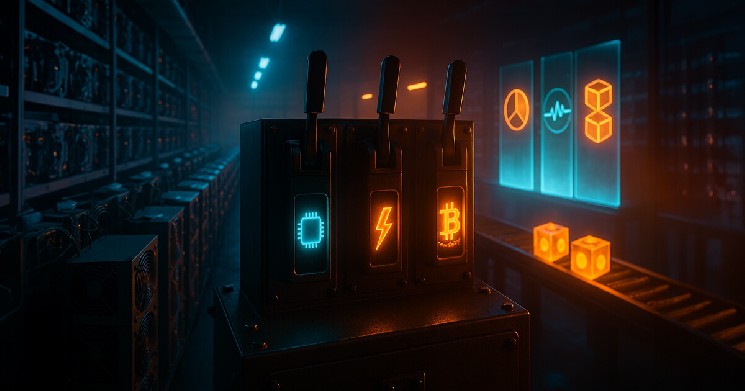This cycle has centered on company Bitcoin bonds, ETF inflows, and modifications in international liquidity, with Bitcoin miners being ignored because the spine of the community.
However as block rewards shrink and vitality prices rise, many corporations are being pressured to reinvent themselves, branching out into AI internet hosting, vitality arbitrage, and infrastructure providers simply to maintain their rigs working and the chain safe.
Bitcoin solely pays out 3.125 BTC per block in subsidies, so transaction charges are at the moment the primary driver of miner income and community safety.
That dependency is obvious in right now’s information factors. The 7-day hashrate is near 1.12 zettahashes per second, and the community issue is roughly 155 trillion.
During the last 144 blocks, miners earned a complete reward of roughly 453 BTC. This equates to roughly $45 million, contemplating the spot value of roughly $101,000.
In line with the mempool.area mining dashboard, the typical payment per block is round 0.021 BTC, making up a small portion of a miner’s revenue.
Hashprice derivatives signify a constrained short-term earnings atmosphere. Luxor’s ahead curve implies round $43.34 per day petahash in October, down from $47.25 in late September.
Price demand stays unstable. Following the April 2024 halving spike related to the launch of Runes, ViaBTC’s halving block garnered over 40 BTC in subsidies and costs, with base charges eased over the summer season.
Galaxy Analysis wrote in August that regardless of value energy, on-chain charges have collapsed to close historic lows, characterizing the payment market as lower than strong.
Pooling insurance policies additional amplify that state of affairs. Foundry and others generally mined transactions for lower than 1 Sat per digital byte. This means that the efficient value ground can collapse in periods when the reminiscence pool is quiet.
Low cost confirmations enhance the person expertise in gentle home windows, however the safety budgets miners accumulate are extra depending on fastened subsidies.
A easy method to body the subsequent quarter is to deal with charges in three regimes and map them to miner income, hash value, and assault value bars.
With 144 blocks per day, a subsidy of three.125 BTC, a community hash charge round 1.13×10⁹ TH/s, and a spot value of about $113,000, charges per block of 0.02 BTC, 0.50 BTC, and 5.00 BTC are about 0.6 p.c, 13.8 p.c, and 61.5 p.c of miner income. Equal to a share fee share.
The every day safety finances, outlined as subsidies and costs over 144 blocks, ranges from roughly 453 BTC on a quiet day to 522 BTC on a quiet day to 1,170 BTC on a peak day.
The impression on hash value will increase mechanically.
The extra payment per block provides ΔF × 144 BTC to your every day income. That is distributed throughout the community hashrate and transformed in spot, growing miners’ income by roughly $0.29, $7.2, and $72 per petahash per day throughout these eventualities.
A ahead of almost $43 per petahash per day signifies that average payment days add a mid-teens enhance to income, whereas peak days reset unit economics.
Power prices are towards the backdrop of those will increase. In line with vendor specs and typical U.S. electrical energy pricing, the present technology fleet primarily based on Bitmain’s Antminer S21 is round 17.5 joules per terahash, whereas MicroBT’s M66S household is round 18-18.5 joules per terahash, round $21-30 per petahash per day, and 5-7 per kilowatt-hour. Face an electrical energy invoice of cents.
With transfers of round $43 per petahash per day, whole energy margins could be skinny earlier than contemplating working and capital prices. Average charge days can enhance the survival of a maxed-out fleet, and repeat peaks can compensate for low charge intervals by boosting money technology.
Safety framing advantages from two boundaries that translate miner income into assault issue.
The decrease sure working value view of a 51% assault assumes that an attacker can procure and function {hardware} at S21 class effectivity.
Controlling 51 p.c of 1.13 ZH/s at 17.5 J/TH leads to energy consumption of just about 10.1 gigawatts. That is roughly 10,085 megawatt-hours per hour and prices roughly $0.50 to $0.71 million per hour at 5 to 7 cents per kilowatt hour.
It is a ground with unrealistic procurement assumptions, and the rental market at the moment can not provide the required capability at that scale. In line with River’s explainer on the 51% assault, that is nonetheless an order of magnitude extra helpful marker.
Higher sure, fastened uppercase points are decided by {hardware} rely. To have 51 p.c of the present hashrate on a 200 TH/s machine would require roughly 2.88 million Antminer S21s.
At $2,460 per unit, that equates to roughly $7.1 billion in {hardware} prices, excluding website, energy contracts, and labor prices, per current media experiences that multi-day management may value billions to tens of billions of {dollars}, primarily based on trade tracker retail costs.
These boundaries are immediately associated to pricing.
As charges proceed to rise, miners’ income, issue, and adjusted equilibrium hashrate rise, which in flip raises each the working value ground and the attacker’s efficient capital bar.
Because the halving proved, spikes as a consequence of inscriptions and volatility, whereas not making a baseline, can fund a big enhance in every day safety budgets.
An open query for the subsequent quarter is whether or not protocol insurance policies and pockets actions can increase the worth ground non-cyclically.
There may be seen progress on this entrance.
Bitcoin Core v28 launched 1-parent-1-child bundle relay, permitting a node to relay low-fee guardian transactions even when the guardian is beneath a minimal relay payment threshold if the kid is paired with a paying little one by way of a mechanism that pays the guardian.
This reduces the danger of transactions getting caught and permits miners to monetize block area that will in any other case be idle. v3 and the TRUC coverage set add strong payment substitute performance for restricted transaction topologies. This reduces lock-ins and allows predictable payment bumping, which is crucial for Lightning Channel operations and batch processing of exchanges.
The momentary anchor proposal introduces a typical anchor output that permits the addition of post-charges by way of CPFP with out extending the UTXO set. These instruments, together with bundle RBF and cluster-aware reminiscence pool work in a easy 1P1C topology, assist miners uncover worthwhile transaction clusters and wallets pay affirmation charges when wanted.
None of this modifications printing demand. Nevertheless, as L2 and exchanges standardize flows, value flooring are typically set, making charge bumping extra dependable.
A minor hedge provides one other ahead information level.
Luxor hash value futures on Bitnomial and the underlying hashrate index community information present a market view of anticipated miner returns. If the ahead curve softens whereas winter energy costs rise, community hashrate may plateau until on-chain charges rise, a pattern that shall be revealed in spot hash costs and difficulties within the coming weeks.
It is also price noting the pool template coverage. If extra swimming pools habitually embrace sub-1 Sat/vB transactions throughout off-peak intervals, the baseline value ground may drift, though improved relay and RBF assist would scale back affirmation instances throughout busy home windows by extra successfully propagating value bump clusters.
The near-term outlook is that with hashrates close to 1.13 ZH/s, or about $43 per petahash per day, modest charges will present sufficient financial impression to maintain maxed-out fleets on-line whereas coverage enhancements work by way of wallets and swimming pools.
With the present parameters, growing the typical payment to 0.5 BTC per block would push the every day safety finances to about 522 BTC at $101,000, or about $52 million.










